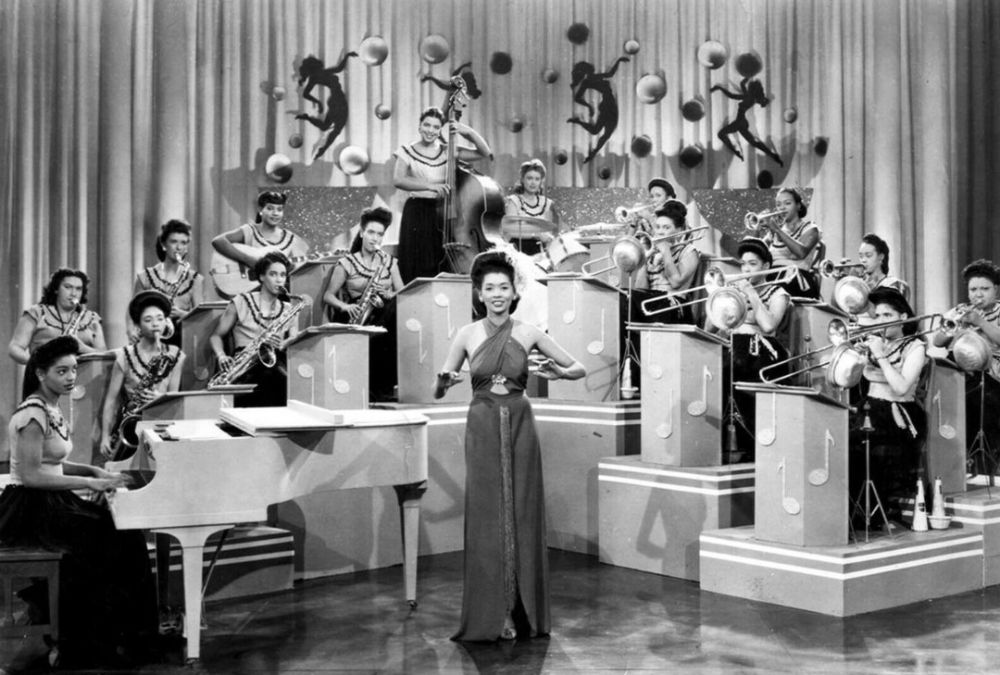EST. 1937
International Sweethearts
The International Sweethearts of Rhythm was the travelling big band from The Piney Woods Country Life School of Mississippi. Formed in 1937 they spent most of the year on the road on extended fundraising trips much in the spirit of The Fisk Jubilee Quartette of the previous century. The young women played dances, auditoriums, and theaters across the South and along the Eastern Seaboard. Their primitive "bus" was a semi-trailer outfitted with wooden bunk beds by the school. Hardly a safe mode of travel, it was, none-the-less, their transportation and their home away from school. Their repertoire tended to hot jazz and swing-era dance tunes.
While most of the bandmembers were schoolgirls, professional trumpeter, Jean Starr, had been with the band since 1940. One early line-up for the band included: Pauline Braddy, Helen Jones, Sadie Pankey, Coreen Posey, Bernice Rothchild, Alma Cortez, Judy Bayron, Helen Saine, Ina Belle Byrd, Nobelee McGhee, Edna Williams, Johnnie Mae Rice, Willie Mae Lee Wong, and Gracie Bayron. More professional musicians including Anna Mae Winburn, Vi Brunside, and Tiny Davis, joined the group after it moved to Washington.
The band was filmed while appearing at the Apollo in New York on a 1941 tour. In the spring of 1941 when the band learned that several members who were scheduled to graduate would be held back, they went out on strike. From their last gig in Florida, they headed to Mobile, Alabama where they sent the bus and the youngest members of the aggregation back to Piney Woods. The balance of the band proceeded to Washington, D.C. where they had previously been well received. Two promoters set them up in housekeeping at 908 South Quinn Street in Arlington, Virginia.
While most of the bandmembers were schoolgirls, professional trumpeter, Jean Starr, had been with the band since 1940. One early line-up for the band included: Pauline Braddy, Helen Jones, Sadie Pankey, Coreen Posey, Bernice Rothchild, Alma Cortez, Judy Bayron, Helen Saine, Ina Belle Byrd, Nobelee McGhee, Edna Williams, Johnnie Mae Rice, Willie Mae Lee Wong, and Gracie Bayron. More professional musicians including Anna Mae Winburn, Vi Brunside, and Tiny Davis, joined the group after it moved to Washington.
The band was filmed while appearing at the Apollo in New York on a 1941 tour. In the spring of 1941 when the band learned that several members who were scheduled to graduate would be held back, they went out on strike. From their last gig in Florida, they headed to Mobile, Alabama where they sent the bus and the youngest members of the aggregation back to Piney Woods. The balance of the band proceeded to Washington, D.C. where they had previously been well received. Two promoters set them up in housekeeping at 908 South Quinn Street in Arlington, Virginia.
From their new "Sweetheart House" the band, under the direction of chaperon Rae Lee Jones, began the transition to professional status. Musical director, Eddie Durham, was hired to begin this process. In 1942 Jesse Stone took over as music director and brought on more seasoned musicians such as Winburn, Davis, and Burnside. The former student musicians also flourished under the new leadership. Touring, recording, and movie making all kept the band with their "runaway" mystique in high demand. The African-American press (primarily weekly newspapers in the major cities) closely tracked their rising fortunes. By 1944 Maurice King of Detroit (later a Motown insider) had taken over as music director. 78rpm single records were made for Guild in 1945, RCA Victor in 1946, and Manor in 1947. They did a lengthy tour of the European Theater of War from July 1945 through January 1946.
Back stateside the band continued a heavy touring schedule, but life was catching up with the young women. Marriages and families began to pull band members away. Some returned briefly, but when their manager and chaperone, Rae Lee Jones, passed away at age 49 in September of 1949, the band effectively broke up. Both Anna Mae Winburn and Vi Burnside formed smaller aggregations which toured and recorded into the early 1950s. The band received belated recognition from the jazz community starting the 1980s. Through their career they were frequently discounted as a "girl-band," but the truth was they were equal to or better than many of contemporary male-only dance bands. The hot jump numbers that they frequently featured helped to lay the foundation for the emergence of rhythm and blues in the late 1940s.
Back stateside the band continued a heavy touring schedule, but life was catching up with the young women. Marriages and families began to pull band members away. Some returned briefly, but when their manager and chaperone, Rae Lee Jones, passed away at age 49 in September of 1949, the band effectively broke up. Both Anna Mae Winburn and Vi Burnside formed smaller aggregations which toured and recorded into the early 1950s. The band received belated recognition from the jazz community starting the 1980s. Through their career they were frequently discounted as a "girl-band," but the truth was they were equal to or better than many of contemporary male-only dance bands. The hot jump numbers that they frequently featured helped to lay the foundation for the emergence of rhythm and blues in the late 1940s.
International Sweethearts
International Sweethearts of Rhythm
